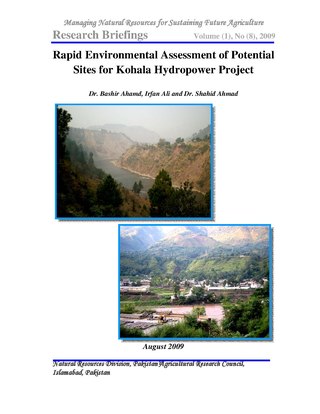
The Kariba Dam is a double curvature concrete arch dam in the Kariba Gorge of the Zambezi river basin between Zambia and Zimbabwe. The dam stands 128 metres (420 ft) tall and 579 metres (1,900 ft) long. The dam forms Lake Kariba, which extends for 280 kilometres (170 mi) and holds 185 cubic kilometres (150,000,000 acre⋅ft) of water.

Hydroelectricity, or hydroelectric power, is electricity generated from hydropower. Hydropower supplies one sixth of the world's electricity, almost 4,500 TWh in 2020, which is more than all other renewable sources combined and also more than nuclear power. Hydropower can provide large amounts of low-carbon electricity on demand, making it a key element for creating secure and clean electricity supply systems. A hydroelectric power station that has a dam and reservoir is a flexible source, since the amount of electricity produced can be increased or decreased in seconds or minutes in response to varying electricity demand. Once a hydroelectric complex is constructed, it produces no direct waste, and almost always emits considerably less greenhouse gas than fossil fuel-powered energy plants. However, when constructed in lowland rainforest areas, where part of the forest is inundated, substantial amounts of greenhouse gases may be emitted.
Wind power is a form of renewable energy in Pakistan which makes up more than 6% of the total electricity production in the country. As of 2018, wind power capacity in Pakistan was 1,287 MW. The government is looking to increase the share of renewable energy and plans to add around 3.5 GW of wind energy capacity by 2018.
The Baihetan Dam is a large hydroelectric dam on the Jinsha River, an upper stretch of the Yangtze River in Sichuan and Yunnan provinces, in southwest China. The dam is a 289-meter-tall double-curvature arch dam with a crest elevation of 827 m, and a width of 72 m at the base and 13 m at the crest. It is considered to be the last large hydropower project in China after a series of projects starting with the Three Gorges Dam. It is also the second largest hydropower plant in the world. The hydropower station is equipped with 16 hydro-generating units each having a capacity of 1 million kilowatts, the world's largest turbines. All hydro-generating units of the Baihetan hydropower station became fully operational on 20 December 2022.

Sinohydro is a Chinese state-owned hydropower engineering and construction company. In the 2012 Engineering News-Record Top 225 Global Contractors, a ranking by annual revenue, the company is 14th by overall position, and 6th among Chinese construction companies.

The Taltson River is a roughly 500 km (310 mi) river in the Northwest Territories of Canada that drains into the Great Slave Lake. There are three hydroelectric power control structures on the river, and one power station.
SEPCO3, stylized as sepcoIII, is a Chinese construction and engineering company that designs, builds, operates and owns power plants.
The Karuma Hydroelectric Power Station is a 600 MW hydroelectric power project under construction in Uganda. When completed, it will be the largest power-generating installation in the country.
Isimba Hydroelectric Power Station is a 183.2 megawatts (245,700 hp) hydroelectric power station commissioned on 21 March 2019 in Uganda. Construction of this dam began in April 2015 and was completed in January 2019. Commercial operations began on 21 March 2019.
Ayago Hydroelectric Power Station, also Ayago Power Station, is a planned 840 megawatt hydroelectric power project to be constructed in Uganda. If it is built, Ayago would be the largest power station in Uganda, based on generating capacity.
Kikagati Hydroelectric Power Station, also referred to as Kikagati Power Station, is a 15.57 MW (20,880 hp) hydroelectric power station, in Uganda.
The China Three Gorges Corporation is a Chinese state-owned power company, established on 27 September 1993. The company was responsible for the construction of the Three Gorges Dam-project, the world's largest hydroelectric power plant, that went into operation in 2008. In September 2002, CTG established the subsidiary company China Yangtze Power, which took over operations and management of Gezhouba and Three Gorges dams. CTG is one of the world's largest energy companies with total assets of RMB 475.5 billion in 2014. Other than hydroelectric dams, the company also operates onshore and offshore wind farms.
Nyagak III Power Station is a 6.6 megawatts (8,900 hp) mini hydroelectric power project, under construction in Uganda.
China International Water & Electric Corporation is a Chinese construction and engineering consulting company that is a subsidiary of China Three Gorges Corporation (CTE). CWE specializes in the construction of water and hydropower projects but its work runs the gamut including road and bridge, power transmission, drainage and sewage treatment systems, dredging, port maintenance, and interior design.
The proposed Batoka Gorge Hydroelectric Power Station is a 2400 MW hydroelectric power station, planned for the Zambezi River on the international border between Zambia and Zimbabwe.

The Kohala Hydropower Project is a proposed run-of-the-river, high head project of 316 meters that will be located near Kohala, in Azad Kashmir. In 2020 the project's agreement was finalised later it was formally signed in a ceremony attended by the Pakistani Prime Minister Imran khan, and Chinese ambassador.

Hydroelectricity is currently China's largest renewable energy source and the second overall after coal. According to the International Hydropower Association, China is the worlds largest producer of hydroelectricity as of 2021. China's installed hydroelectric capacity in 2021 was 390.9 GW, including 36.4 GW of pumped storage hydroelectricity capacity, up from 233 GW in 2011. That year, hydropower generated 1,300 TWh of power, an increase of 68 TWh over 2018 when hydropower generated 1,232 TWh of power, accounting for roughly 18% of China's total electricity generation.






